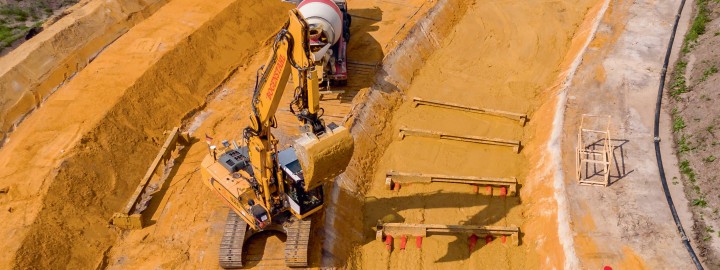Construction process and recultivation

The task of building underground cable links as cost-effectively and in as “soil-friendly” a way as possible is a challenge Amprion – working hand in hand with research institutes, experts and professional associations – is very willing to take on. Underground cables can be laid using a number of different methods. Whether an open or a closed construction method is chosen depends, among other things, on the respective soil and groundwater conditions and the natural geographical and also man-made features of the landscape – such as rivers or motorways that may have to be crossed. Furthermore, we always take aspects relating to environmental law into account when choosing the construction method.
The open construction method: Raesfeld, for example
Particularly when laying underground cables in open trenches under agricultural land, it’s essential that we go easy on the ground, the soil and its water balance (hydrology). We’ve already gained extremely valuable experience and know-how in this regard from our first pilot section in Raesfeld, where we successfully installed the underground cables in an open trench while protecting the soil. We cooperated closely with the local farmers and actively sought and acted upon the advice of agricultural scientists.

DC transmission: laying cables on open/agricultural land
DC cable system for transmitting 2,000 MW
Layer for layer
Underground cable projects demand a huge amount of detailed information on the composition of the soil. Whereas in the case of an overhead line Amprion surveys the ground only at the points where the pylons are to stand, that is, typically every 400 metres, test drillings have to be made every 50 to 250 metres when planning a cable route. The test samples are then analysed by pedologists (soil scientists), who determine how the various soil layers are to be handled. The more layers there are, the more complicated it is to excavate and later backfill the soil. Remember that the individual layers have to be carefully separated. The data from the soil analysis is incorporated into the plans for the cable system and the expert opinion itself lays down essential soil protection measures for each section of the route. Independent soil experts monitor the construction activities on site throughout the entire project.
Bedding the cables
To begin with, excavators remove the soil layer by layer and deposit these layers separate from one another at the side of the cable trench. At a depth of around two metres, we then lay empty conduits for the cables that are later fed through in stages. The conduits lie in a stone-free bedding material that very effectively deflects and dissipates heat and allows the soil to drain in a controlled manner.
As the cables emit heat, they have to be laid a good half a metre apart depending on the power level to be transmitted. Given the number of cables necessary – in Raesfeld there are 12 parallel individual conductors – this means the amount of excavation work involved for cable systems for the transmission grid far exceeds that necessary for distribution networks.

AC transmission: laying cables on open/agricultural land
AC cable system for transmitting up to 4,000 MW
Backfilling and recultivation
The cable trench is backfilled in reverse order to excavation – from the bottommost to the topmost layer. To minimise settlement and to prevent cavities from forming, we backfill the earth as finely grained as possible. It has to be dry to do this and wet, even damp, weather can slow down construction work accordingly. Afterwards, the various layers lie almost exactly as they did before we started work: the structure of the soil is maintained and it is able to regenerate very quickly. A soil scientist accompanies and monitors the construction and recultivation activities.
Closed construction
Open construction is not the method of choice for all situations. If we have to run the underground cables under water or roadways, the closed construction method offers genuine advantages – despite being far more expensive and time-consuming. The only points at which we require areas for setting up construction site equipment is at the start and destination points of such a route. There are a number of different processes available, such as pilot tube tunnelling, horizontal wash drilling and microtunnelling. Which method we choose depends on the local geology and the length of the route.

Microtunnelling
Various methods are available for closed construction.
